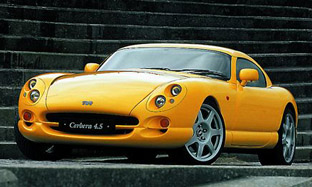
The
TVR Cerbera is a performance bargain - but it's also a
bit of a handful
|
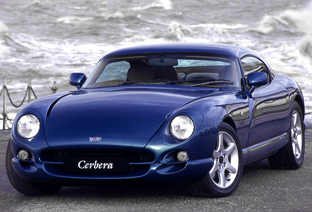
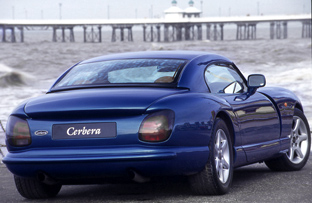
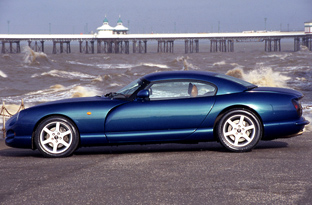
For
a two-door coupe the TVR Cerbera has an elongated
profile
|
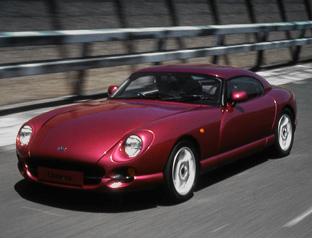
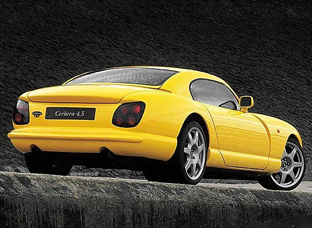
The
TVR Cerbera's bodywork is powerful and dramatic
|
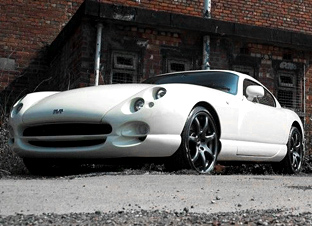
This
is the last TVR Cerbera 4.5 ever sold by the factory
|
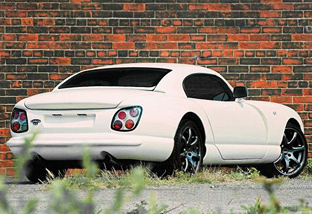
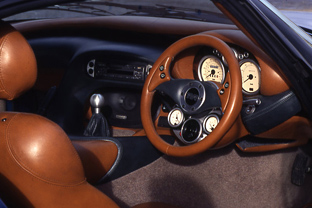
The
interior of the TVR Cerbera features very unusual
styling and custom switchgear
|
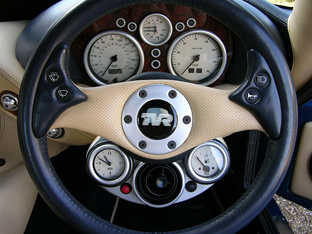
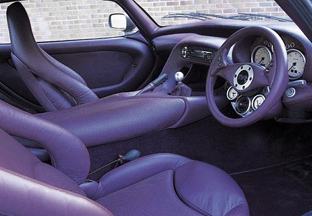
|
|
| Year
(of specifications) |
1996
- 2004 (all Cerberas) |
| Engine |
4578
cc 8 cylinder |
| Transmission |
5
speed manual RWD |
| Max
speed |
180 +
mph
|
| 0-60
mph |
3.9
seconds |
| Horsepower |
420
bhp @ 6750 rpm |
| weight |
1100
kgs |
Background
The Cerbera is a brutish, leery British muscle car, and TVR
at its best. It's not a refined and dainty sports car suitable
for those new to RWD vehicles.
There are no electronic aids to stop you getting into trouble,
and the sensitive steering takes some getting used to. Not that
the steering is bad, it's just different to what you might initially
expect.
Like many low volume UK manufactured sports cars, the TVR Cerbera
isn't going to win any awards for reliability, and the temperamental
electronics are just one of the weak spots. The clutches
also have a disturbing habit of grenading themselves prematurely.
The engines (both the V8's and the V6), if properly maintained
are generally quite solid. But if left unserviced and unchecked
the problems can quickly spiral out of control.
The Cerbera isn't what you'd call a sensible choice. It should
only be bought by those who want a characterful, talking-point
type of car, and are prepared to put up with a few issues and
unexpected roadside pit-stops.
Drivetrain
Over the Cerbera's 8 year lifespan there were three different
engine variants - all designed and produced in-house by TVR.
Initially the car was fitted with a 4.2 litre V8 which produced
360 horsepower. Two years later a 4.5 litre V8 option was included.
This car, the Cerbera 4.5, became the top spec model for the
rest of the car's production run. Power output for the Cerbera
4.5 was 420 hp @ 6,750 rpm, and 380 lb-ft of torque
@ 5,500 rpm.
Later models of the Cerbera 4.5 were given the option of a 'Red
Rose' specification, which increased its output to 440 bhp when
fueled with super-unleaded (high octane)
fuel and the driver pushed an unmarked button on the dashboard
which altered the engine mapping to suit.
In 1999 the TVR Cerbera
Speed Six appeared. Power for this model came from a 4.0
litre slant-six engine which developed 350 hp.
All the engines produce a fabulous, thundery soundtrack and
offer up waves of torque throughout the rev range.
In general all the engines are pretty reliable if, and that's
a massive IF, they are properly maintained.
The V8's are a bit more fussy than the V6 about servicing. Every
24,000 miles the tappets should be checked and re-shimmed -
a time consuming job. The six-cylinder engine requires the same
job, but at every 12,000 miles. Fortunately it's a considerably
easier job on the Six.
The V8 can also suffer from leaks (see how to identify
vehicle leaks), most commonly from the front cover.
Thankfully, despite the demise of TVR as a manufacturer, TVR
Power - the engine division - is still around to provide maintenance,
servicing and parts.
The Cerbera's transmission
is a very solid Borg-Warner T5 5-speed unit. Aside from the
possibility of wear on the 2nd and 5th gear synchromesh after
many, many miles the gearbox has no reliability issues to watch
out for.
Sadly the same can't be said of the clutch. Usually they last
around 25,000 miles. Often the clutch will fracture the fingers
on the pressure plate well before the clutch plates are actually
in need of replacement.
Body and Chassis
The TVR Cerbera has a gorgeous fiberglass
body which was exceptionally well finished. The curvaceous styling
is one of the car's strong points, and overall the bodywork
doesn't throw up too many problems. Door seals can leak and
that's about it.
Unfortunately the leaking seals can allow water to get down
to the steel chassis, if left unattended it can lead to extensive
rusting, and ultimately a new chassis can be required!
The most vulnerable chassis section is the area at the back
of the front wheel arch. If you're looking at buying a Cerbera
check the chassis thoroughly to make sure there's no damage
to the powder coating, or that there's no rust spots.
Suspension
The Cerbera has a relatively harsh ride but not overly so. The
sporty suspension setup, coupled with the quick steering rack
can make the car feel a little nervous on uneven surfaces. The
car is also prone to snap-oversteer, especially in the wet.
Interior
The interior of the TVR is like no other car, well except maybe
some other Looney Tunes TVR's. It's a crazy mix of swoops, curves
and rounded surfaces. TVR made all their own switchgear for
the car - which is highly unusual for a small-volume manufacturer.
Overall the leather trimmed interior of the Cerbera is a very
unique place indeed.
The only issue with the interior is temperamental electronics.
So check all the switchgear works the way it should.
Similar and related vehicles:
 TVR T400R/T440R
TVR T400R/T440R
 TVR Sagaris
TVR Sagaris
 TVR T350
TVR T350
 TVR Tuscan 2 S
TVR Tuscan 2 S
 TVR Tamora
TVR Tamora
 TVR Cerbera Speed Twelve
TVR Cerbera Speed Twelve
 TVR Chimaera 5.0
TVR Chimaera 5.0
 TVR Griffith 500
TVR Griffith 500
 TVR Cerbera Speed Six
TVR Cerbera Speed Six
 TVR S3C
TVR S3C
|
|

